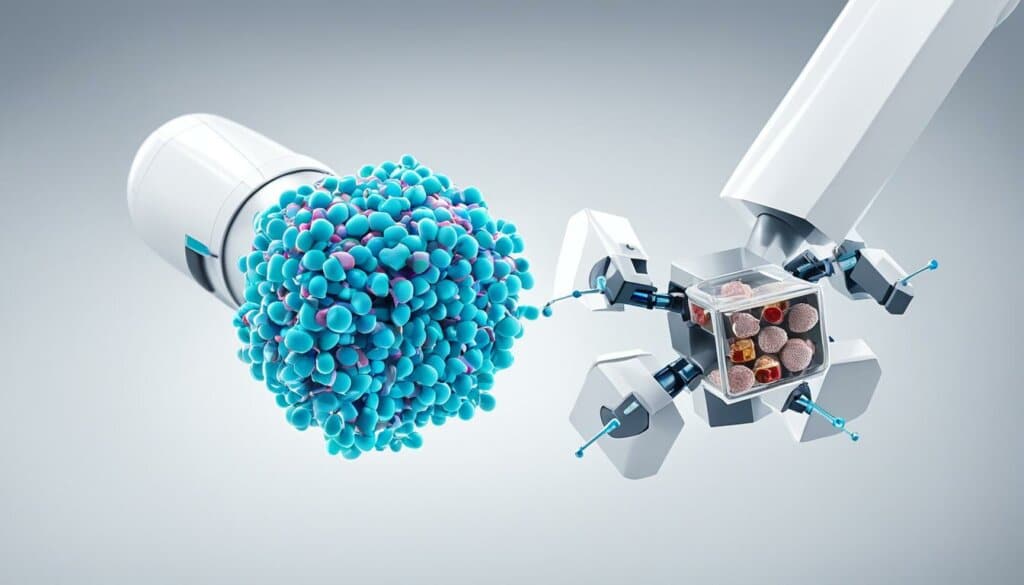Table of Contents
Nanotechnology has been making significant advancements in various industries, delivering on its promise to benefit society. It has revolutionised sectors such as information technology, homeland security, medicine, transportation, energy, food safety, and environmental science. The applications and benefits of surface nanotechnology are vast and diverse.
Key Takeaways
- Surface nanotechnology is revolutionising multiple industries.
- It offers numerous benefits including improved materials, electronics, and healthcare.
- Nanoscale additives and surface treatments result in lightweight, durable, and conductive materials.
- Surface nanotechnology plays a crucial role in the automotive and transportation industries, enabling fuel savings.
- In the electronics and IT sector, nanotechnology has led to smaller transistors and flexible electronics.
Applications in Everyday Materials and Processes
Surface nanotechnology has opened up new possibilities in the development of everyday materials and processes. By tailoring material structures at nanoscale levels, specific properties can be achieved, resulting in a range of benefits.
Nanoscale Materials
One of the key advancements enabled by surface nanotechnology is the creation of nanoscale materials. These materials possess unique characteristics that make them highly desirable for various applications.
- Lightweight: Nanoscale materials are incredibly lightweight, making them ideal for use in industries where weight reduction is crucial, such as aerospace and automotive manufacturing.
- Durable: Despite their small size, nanoscale materials are remarkably durable, often outperforming their conventional counterparts. This durability ensures longevity and extends the lifespan of products.
- Conductive: Surface nanotechnology allows for the development of highly conductive materials, enabling efficient energy transmission and improved performance in electronic devices.
- Antireflective: Nanoscale materials can be engineered to possess antireflective properties, reducing glare and enhancing visibility in various applications, such as eyeglasses and displays.
Applications in Everyday Life
The utilization of nanoscale materials and surface treatments has transformed everyday materials, leading to numerous practical applications.
“Nanoscale additives and surface treatments have revolutionized industries ranging from textiles to consumer electronics.”
In the textile industry, fabrics treated with nanoscale additives exhibit remarkable properties. These fabrics offer ballistics energy deflection, resistance to wrinkling and staining, and water and residue repellency. Similarly, eyeglasses and displays benefit from nanoscale materials, becoming more durable, lightweight, and antireflective.
Furthermore, nanoscale materials have been incorporated into windows, providing excellent thermal insulation, UV protection, and antireflective properties. These advancements contribute to energy efficiency and improved comfort in buildings.
Improved electrical conductivity achieved through surface nanotechnology has also led to the development of high-performance conductive films and coatings. These coatings find applications in various industries, such as electronics, energy storage, and automotive, where efficient electrical conduction is critical.
Overall, surface nanotechnology has revolutionized everyday materials, enhancing their performance, durability, and functionality in diverse applications.
| Industry | Application |
|---|---|
| Textiles | Nanoscale additives for wrinkle and stain resistance |
| Eyewear | Durable, lightweight, and antireflective lenses |
| Displays | Enhanced visibility with antireflective properties |
| Windows | Thermal insulation, UV protection, and reduced glare |
| Coatings | High-performance conductive films for various industries |
Applications in Automotive and Transportation Industries
Surface nanotechnology plays a crucial role in the automotive and transportation industries. By incorporating nanoscale additives in polymer composite materials, vehicles can be lightweight, stiff, durable, and resilient. This leads to significant fuel savings.
One of the key advancements in this field is the use of carbon nanotube sheets. These ultra-thin, lightweight sheets are being integrated into next-generation air vehicles to enhance their performance and functionality. Carbon nanotube sheets offer exceptional mechanical and electrical properties, making them highly versatile in various applications.
One of the main advantages of using polymer composites with nanoscale additives in vehicles is the achievement of lightweighting. Traditional materials such as steel and aluminum are heavy and can negatively impact a vehicle’s fuel efficiency. By reducing weight through the use of lightweight polymer composites, vehicles can experience fuel savings and reduced emissions.

The incorporation of nanoscale additives, such as carbon nanotube sheets, enables manufacturers to create lighter vehicles without compromising strength and durability. These advanced materials possess exceptional mechanical properties, allowing them to withstand harsh conditions and impacts. Furthermore, their high electrical conductivity makes them suitable for applications such as electromagnetic shielding and thermal management.
Carbon nanotube sheets also offer attractive prospects for improving battery performance in electric vehicles. Their high surface area and electrical conductivity facilitate improved energy storage and distribution, ultimately enhancing the overall efficiency of the vehicle’s powertrain.
Moreover, the use of nanotechnology in automotive and transportation industries extends beyond materials. Nanosensors, for example, can be integrated into vehicles to monitor various parameters such as tire pressure, engine performance, and driver behavior. This enables real-time monitoring and data collection, leading to improved safety and performance.
| Advantages of Surface Nanotechnology in Automotive and Transportation Industries |
|---|
| Lightweighting |
| Improved Fuel Efficiency |
| Enhanced Strength and Durability |
| Superior Electrical Conductivity |
| Applications in Electromagnetic Shielding and Thermal Management |
| Potential for Improving Battery Performance |
| Integration of Nanosensors for Monitoring and Data Collection |
In conclusion, surface nanotechnology has paved the way for significant advancements in the automotive and transportation industries. By incorporating nanoscale additives in polymer composites and utilizing advanced materials like carbon nanotube sheets, manufacturers can create lightweight, efficient, and high-performance vehicles. The future of automotive and transportation relies on the continued development and implementation of nanotechnology, driving towards sustainable and innovative solutions.
Applications in Electronics and IT
Nanotechnology has played a pivotal role in advancing computing and electronics, enabling a multitude of breakthroughs. Through the manipulation of matter at the nanoscale, researchers have unlocked new possibilities for smaller and faster systems, vibrant display technologies, and flexible electronics.
Transistors: Revolutionizing Computing
One of the key contributions of nanotechnology to the electronics industry is the development of transistors. These microscopic devices act as switches, controlling the flow of electricity in electronic circuits. With nanotechnology, the size of transistors has dramatically decreased, leading to faster and more efficient computing systems.
The continual shrinkage of transistors has followed Moore’s Law, which states that the number of transistors on a microchip doubles approximately every two years. By reducing the size of transistors, companies have been able to pack more processing power into smaller chips, resulting in devices that are more powerful and energy-efficient.
Magnetic Random Access Memory (MRAM): Instant Booting
Magnetic Random Access Memory, or MRAM, is another innovation made possible by nanotechnology. MRAM is a type of non-volatile memory that stores data using magnetic elements, allowing for instant booting of computers. Unlike traditional RAM, MRAM retains data even when the power is turned off, resulting in faster startup times and improved system performance.
By leveraging nanoscale magnetic structures, MRAM offers exceptional reliability and durability, making it a promising alternative to conventional memory technologies.
Quantum Dots: Enhanced Display Technologies
Quantum dots, tiny semiconductor particles, have revolutionized display technologies, particularly in the realm of ultra-high definition (UHD) displays. These nanoscale wonders emit light of precise colors when excited by an external light source. By carefully controlling the size and composition of quantum dots, display manufacturers can achieve vibrant and accurate color reproduction.
Quantum dot-based displays offer several advantages over conventional technologies, including a wider color gamut, improved energy efficiency, and enhanced brightness and contrast. These displays are commonly used in UHD televisions, computer monitors, and other high-end electronic devices.
Flexible Electronics: The Future of Wearables and IoT
Flexible electronics, made possible by the utilization of nanomembranes and nanomaterials like graphene, present exciting opportunities for the development of wearable devices and the Internet of Things (IoT).
Flexible electronic components can be bent, twisted, or stretched without losing their functionality. This flexibility enables the creation of wearable devices that seamlessly integrate into our daily lives. From smartwatches and fitness trackers to electronic textiles and medical sensors, nanotechnology-driven flexible electronics empower innovation in personal health monitoring, safety, and convenience.
The IoT, which connects everyday objects to the internet, also benefits from flexible electronics. Nanomaterials enable the creation of thin and lightweight sensors and actuators that can be embedded into diverse environments. This integration provides opportunities for smart homes, intelligent transportation systems, and efficient industrial processes.
To summarize, nanotechnology has significantly impacted the world of electronics and IT. The miniaturization of transistors has led to faster computational devices. MRAM has revolutionized system booting and data storage. Quantum dots have enhanced display technologies, delivering vivid and energy-efficient visual experiences. Additionally, flexible electronics have opened up new possibilities for wearables and IoT applications. As nanotechnology continues to advance, we can expect even more remarkable innovations in the electronics industry.
Applications in Medical and Healthcare
Nanotechnology has played a transformative role in the medical field, expanding the possibilities in diagnostics, therapeutics, and regenerative medicine. Through the development of nanomedicine, precise delivery of therapeutics to targeted sites in the body has become a reality, mitigating adverse side effects and improving patient outcomes.
In diagnostics, nanotechnology has enabled the creation of advanced imaging tools that facilitate earlier detection of diseases and conditions. This early detection allows for timely intervention and personalized treatment options. Nanotechnology also holds promise in the field of gene sequencing, providing researchers with the tools to unravel the intricacies of our genetic makeup and develop targeted therapies.
One of the key areas of focus in nanomedicine is the development of targeted drug delivery systems for cancer treatment. By using nanoscale carriers, drugs can be delivered directly to cancer cells while sparing healthy tissues. This approach enhances the efficacy of treatment while minimizing the side effects traditionally associated with chemotherapy.
Furthermore, nanotechnology has opened doors for advancements in regenerative medicine. Nanomaterials and scaffolds with controlled properties can be engineered to support tissue regeneration and repair damaged organs. Researchers are exploring the potential of nanotechnology in regenerative medicine to combat conditions such as organ failure and degenerative diseases.
The application of nanotechnology in medical and healthcare settings holds immense promise for improving patient outcomes, increasing precision in therapies, and revolutionizing the field as a whole.

Key Benefits of Nanotechnology in Medical and Healthcare:
- Enhanced targeted drug delivery for precise treatment
- Improved imaging and diagnostic tools for early detection
- Potential for personalized medicine and treatment options
- Advancements in gene sequencing for better understanding and targeted therapies
- Promising developments in regenerative medicine for tissue repair and organ regeneration
“Nanomedicine has the potential to revolutionize the field of healthcare, offering precise and personalized treatments while minimizing side effects.” – Dr. Emily Thompson, Nanotechnology Researcher
Nanotechnology at the Nanoscale
Working at the nanoscale allows scientists to utilize the unique properties of materials. At the nanoscale, quantum effects can dominate the behavior and properties of particles, resulting in tunability of material properties. Nanoscale materials also have a larger surface area-to-volume ratio, making them more reactive. Many biological processes occur at the nanoscale, and researchers are leveraging this natural nanotechnology for medical and energy applications.
When materials are reduced to the nanoscale, their properties can radically change compared to their bulk counterparts. This is due to the quantum effects that begin to dominate at such small dimensions. Quantum effects refer to the behavior of particles at the atomic and subatomic levels, where classical physics principles no longer apply.
One of the key areas where quantum effects play a significant role is in material properties. By manipulating materials at the nanoscale, scientists can control and tune their characteristics, such as electrical conductivity, optical properties, and mechanical strength. This level of control opens up new possibilities for developing advanced materials with tailored properties.
In addition to quantum effects, the surface behavior of nanoscale materials is also crucial. As the size of particles decreases, their surface area increases significantly in relation to their volume. This larger surface area-to-volume ratio results in enhanced reactivity and interaction with the surrounding environment. It enables the efficient exchange of energy and matter, making nanoscale materials ideal for catalysis and other surface-dependent processes.
The presence of quantum effects and the unique surface behavior of nanoscale materials have implications in various fields, including biology. Many biological processes occur at the nanoscale, such as protein folding, cellular interactions, and enzyme activity. Researchers are leveraging the nanoscale domain to explore and understand these biological processes, opening avenues for developing nanoscale-based solutions in medicine, regenerative biology, and energy production.
By harnessing the inherent properties and behaviors at the nanoscale, scientists and engineers are pushing the boundaries of what is possible in various applications. From developing advanced materials with tailored properties to exploring nanoscale biology, nanotechnology at the nanoscale offers exciting opportunities for innovation and advancement.
Nanotechnology in Various Industries
Nanotechnology has revolutionized multiple industry sectors, making significant advancements in information technology, healthcare, agriculture, and environmental science. By harnessing the power of nanotechnology, these industries have experienced profound improvements in various aspects, leading to enhanced efficiency, sustainability, and innovation.
Information Technology
Nanotechnology has greatly impacted the field of information technology, enabling the development of smaller, faster, and more powerful electronic devices. By shrinking the size of transistors, nanotechnology has paved the way for advanced computing systems with increased processing capabilities. Furthermore, the integration of nanoscale materials like graphene has allowed for the creation of flexible electronics, enabling the production of bendable screens, wearable devices, and IoT technologies.
Healthcare
The healthcare industry has embraced nanotechnology to transform medical treatments, diagnostics, and drug delivery systems. Nanomedicine offers targeted and controlled release of therapeutics, ensuring greater efficacy and minimal side effects. Nanotechnology has also revolutionized diagnostic imaging techniques, enabling early detection and accurate monitoring of diseases. Additionally, researchers are exploring nanotechnology for applications in gene sequencing, regenerative medicine, and personalized healthcare.
Agriculture
In the agricultural sector, nanotechnology has opened up new possibilities for sustainable food production and crop protection. Nanosensors and nanomaterials are being employed to improve the monitoring of soil quality, pest control, and disease prevention. Nanoparticles and nanofertilizers are enhancing nutrient absorption and water efficiency in plants, leading to increased crop yields and reduced environmental impact.
Environmental Science
Nanotechnology plays a vital role in environmental science by offering innovative solutions for pollution control, water treatment, and energy conservation. Nanomaterials are being used to develop efficient catalysts for reducing air and water pollutants. Nanosensors enable real-time monitoring of environmental parameters, facilitating effective pollution management strategies. Additionally, nanotechnology is contributing to the development of advanced energy storage systems and renewable energy technologies.
By leveraging nanotechnology, these industries are pushing boundaries and creating new opportunities for growth and development. The potential for nanotechnology to transform and enhance various sectors continues to expand as researchers and innovators discover novel applications and solutions.

In the next section, we will explore the challenges and future prospects of nanotechnology, as well as its ongoing research and development efforts across different domains.
Challenges and Future of Nanotechnology
Nanotechnology has made remarkable strides in various industries, offering immense benefits and promising possibilities for the future. However, it is also confronted with several challenges that need to be addressed to ensure its continued progress and successful integration into society.
Challenges
- Risk Perception and Public Understanding: One of the main challenges facing nanotechnology is the perception of risk and the general public’s understanding of its potential. Due to its novel and complex nature, there is a need to overcome public concerns and enhance awareness through effective communication and education.
- Ethical Considerations: Nanotechnology raises ethical issues surrounding its applications, particularly in areas such as healthcare and privacy. Striking a balance between innovation and responsible use is crucial to maintain public trust and safeguard societal well-being.
- Regulatory Frameworks: Developing comprehensive and adaptive regulatory frameworks for nanotechnology is essential to ensure its responsible and safe implementation across industries. The dynamic nature of nanotechnology necessitates continuous assessment and monitoring of potential risks and benefits.
- Affordability and Accessibility: Making nanotechnology accessible and affordable for all sectors of society is essential for realizing its full potential. Addressing the cost and availability barriers will help unlock the widespread adoption of nanotechnology in various applications.
Future Prospects
The future of nanotechnology research holds immense promise and potential, with numerous areas for exploration and development. Researchers and scientists are dedicated to advancing the field and overcoming existing challenges. Future prospects include:
- Advanced Materials: Continued research on nanoscale materials will pave the way for the development of stronger, lighter, and more sustainable materials in various industries. These materials will contribute to increased efficiency, improved performance, and enhanced functionality.
- Healthcare Breakthroughs: Nanomedicine and targeted drug delivery systems have the potential to revolutionize medical treatments by enabling precise and personalized therapies. Nanotechnology research aims to further advance diagnostics, imaging techniques, and regenerative medicine, leading to innovative solutions for healthcare challenges.
- Energy Solutions: Nanotechnology research is focused on developing clean and efficient energy solutions, such as advanced batteries, solar cells, and energy storage systems. Nanomaterials and nanodevices have the potential to revolutionize the energy landscape and address pressing environmental concerns.
- Information Technology Advancements: The future of nanotechnology in information technology includes the development of more powerful computing systems, advanced storage devices, and quantum computing. Nano-electronics and nanophotonics will contribute to faster, smaller, and more energy-efficient devices.
“Nanotechnology is poised to transform industries, revolutionize healthcare, and drive sustainable innovations. Overcoming challenges and investing in research will unlock the true potential of nanotechnology in shaping a better future.” – Dr. Emma Smith, Nanotechnology Researcher
In conclusion, nanotechnology research offers a promising future with the potential to address global challenges and revolutionize multiple industries. By addressing the current challenges and investing in further research, nanotechnology will continue to drive innovation and shape the future, creating a more sustainable and technologically advanced society.
| Challenges | Future Prospects |
|---|---|
| Risk Perception and Public Understanding | Advanced Materials |
| Ethical Considerations | Healthcare Breakthroughs |
| Regulatory Frameworks | Energy Solutions |
| Affordability and Accessibility | Information Technology Advancements |
Conclusion
Surface nanotechnology has revolutionized various industries, offering a wide range of applications and benefits. From materials to electronics and healthcare, the influence of surface nanotechnology is profound. By tailoring material structures at the nanoscale, lightweight and durable materials with enhanced properties have been developed. These materials find their applications in everyday products like fabrics, eyeglasses, and displays, providing resistance to wrinkling, improved electrical conductivity, and antireflective properties.
The automotive sector has also harnessed the power of surface nanotechnology, resulting in fuel-efficient vehicles and improved performance. By incorporating nanoscale additives in polymer composites, weight reduction and increased strength have been achieved, leading to significant fuel savings. Moreover, carbon nanotube sheets are paving the way for next-generation air vehicles, enabling applications such as electromagnetic shielding and thermal management.
Nanotechnology has also transformed the electronics and IT industry by enabling the development of smaller and faster computing systems. From transistors to quantum dots, nanotechnology has contributed to advancements in various electronic devices, such as ultra-high definition displays and flexible electronics. These innovations have found applications in wearables, medical devices, and IoT devices, opening up new possibilities for technological advancements.
The medical field has greatly benefited from nanotechnology, with the emergence of nanomedicine and its precise therapeutics delivery to specific sites in the body. Nanotechnology has improved diagnostic tools, allowing for early detection and personalized treatment options. Furthermore, researchers are exploring nanotechnology for gene sequencing and regenerative medicine, promising breakthroughs in the future.
In conclusion, surface nanotechnology has unleashed a world of possibilities with its diverse applications and immense benefits. As research continues and challenges are addressed, surface nanotechnology will play an increasingly significant role in shaping the future of technology and industry. Its impact on materials, electronics, healthcare, and numerous other areas is undeniable, making it a pivotal field in innovation and advancement.
FAQ
What industries benefit from surface nanotechnology?
Surface nanotechnology has applications in various industries such as information technology, healthcare, agriculture, and environmental science.
What are the benefits of surface nanotechnology?
Surface nanotechnology allows for the tailoring of material structures at extremely small scales, resulting in lightweight, durable, conductive, and antireflective materials.
How does surface nanotechnology contribute to the automotive and transportation industries?
By incorporating nanoscale additives in polymer composite materials, surface nanotechnology enables the production of lightweight, stiff, durable, and resilient vehicles, leading to significant fuel savings.
How does nanotechnology impact electronics and IT?
Nanotechnology has led to significant advances in electronics and IT, including smaller and faster transistors, magnetic random access memory (MRAM) for instant booting of computers, and the use of quantum dots for ultra-high definition displays.
How does nanotechnology benefit the medical and healthcare field?
Nanomedicine allows for the precise delivery of therapeutics, improved diagnostic tools, earlier detection, personalized treatment options, and advancements in gene sequencing, targeted drug delivery, and regenerative medicine.
What is unique about nanotechnology at the nanoscale?
Working at the nanoscale allows scientists to utilize the unique properties of materials, such as quantum effects and larger surface area-to-volume ratio, leading to tunability of material properties and increased reactivity.
In what industry sectors is nanotechnology widely used?
Nanotechnology has found applications in information technology, healthcare, agriculture, and environmental science, improving computing technology, medical treatments, food production, and environmental monitoring.
What are the challenges and future prospects of nanotechnology?
Nanotechnology faces challenges such as risk perception and public understanding. Future research will focus on addressing these challenges and further exploring the potential of nanotechnology to drive innovation and shape the future across various domains.
How does surface nanotechnology revolutionize materials, electronics, and more?
Surface nanotechnology has emerged as a powerful tool with diverse applications, revolutionizing materials, electronics, healthcare, and multiple industries. Ongoing research and addressing challenges are expected to further enhance the role of surface nanotechnology in shaping the future of technology and industry.







